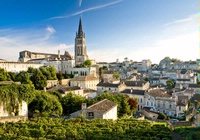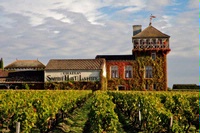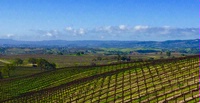|
|
 |
|
April 28, 2017
BORDEAUX, France — The warm, dry summer of 2016 provided ideal conditions for an excellent grape harvest throughout the Bordeaux region.
The Right Bank, planted heavily with merlot and cabernet franc, was no exception. The merlot in Pomerol delivered outstanding color and concentration, as did the merlot and cabernet franc of Saint-Emilion. Even the few plots of cabernet sauvignon that typically struggle to ripen in the cold clay and limestone soils east of the river Gironde matured to perfection.
The quality of the vintage was exceptional, and the yields were bountiful, a welcome gift for the Bordelaise, who are all too familiar with so-called "off" and often "short" vintages. Vintage 2016 has the whole of Pomerol and Saint-Emilion smiling.
 The Right Bank is a large area with many satellite appellations that produce excellent wines in good years, but my evaluations are based upon the selection of wines presented by the Union des Grands Crus de Bordeaux, or UGCB, at its annual en primeur tastings, the coming-out party each spring for the new wines from the previous year. The Right Bank is a large area with many satellite appellations that produce excellent wines in good years, but my evaluations are based upon the selection of wines presented by the Union des Grands Crus de Bordeaux, or UGCB, at its annual en primeur tastings, the coming-out party each spring for the new wines from the previous year.
The wines presented by the UGCB represented producers of Saint-Emilion grand cru and a number of top chateaux from Pomerol, which has no classification system. There is worldwide interest in the quality of these wines because many are offered for sale as futures — to be delivered when the wines are ready for commercial release in a couple of years. Futures prices are generally lower than release prices two years hence, when the quality of the vintage has been firmly established and demand is at its peak. Futures prices for the 2016 vintage have not yet been announced.
For the purpose of this report, my focus is on the more affordable wines presented at the UGCB tastings, not the prohibitively expensive wines of star chateaux, such as Cheval Blanc, Petrus, Ausone and their ilk. That is not to imply the wines evaluated are not expensive. They are but less so than the trophy wines hunted down by well-heeled collectors and speculators.
I use a four-point range when evaluating barrel samples, due to the volatility and fragility of young wines that have yet to be bottled. I look for color, concentration, balance, quality of tannins and overall potential based on more than 35 years of experience with very young and very old Bordeaux.
My personal assessment of the 2016 vintage in Pomerol and Saint-Emilion is very high, with the caveat that I believe the Left Bank is slightly more consistent. I attribute much of the difference to the obsession with new oak in Saint-Emilion, which can be a flaw if it either overwhelms the fruit or imparts astringent wood tannins, which can influence a wine throughout its lifespan, however long that may be.
That said, there were many stunning wines produced on the Right Bank in 2016, and overall, the wines of Saint-Emilion grand cru were more successful than those of Pomerol. The following are my personal recommendations.
Saint-Emilion Grand Cru
Chateau Canon La Gaffeliere — Good concentration, richness and length on the palate without being overextracted. Could blossom well. Good long-term potential. 90-93.
Chateau Dassault — Excellent concentration, pretty red fruits, integrated tannins, suave elegance. Outstanding long-term potential. 91-94.
Chateau La Dominique — Good concentration, complexity of black and red fruit, elegant tannins. Excellent long-term potential. 90-93.
Chateau Grand Mayne — Pretty wine with a suave palate. Good concentration. Integrated tannins. Complex layers of fruit. Excellent long-term potential. 93-96.
Chateau La Tour Figeac — Rich and bold, with fleshy ripe fruit and firm tannins. Exceptional long-term potential. 94-97.
Chateau Troplong Mondot — Excellent concentration, dense and rich, with firm tannins. Black and red fruits. Excellent long-term potential. 93-96.
Pomerol
Chateau Beauregard — Suave and rich on the palate, with good concentration and supple tannins. Exceptional long-term potential. 91-94.
Chateau Le Bon Pasteur — Fleshy but with firm structure. Nice plum notes. Very good medium-term potential. 88-91
Chateau La Cabanne — Red fruits, concentrated, with bold and aggressive tannins. Very good medium-term potential. 89-92.
Chateau Clinet — Fleshy fruit on the palate with firm tannins. Excellent structure and balance. Very good medium-term potential. 88-91.
Follow Robert on Twitter at @wineguru.
Posted by Robert Whitley at 12:00 AM
|
|
April 19, 2017
Creators Syndicate
BORDEAUX, France — The drumbeat for a great vintage has been mastered here in Bordeaux, and sometimes the Bordelaise even get it right.
But after the first day of tasting wines from the 2016 vintage at the annual En Primeur event for the wine press, hosted by the Union des Grands Crus de Bordeaux, the jury is still out in my estimation. To be sure, there are many exceptional wines, though anyone would be hard-pressed after the first day to make the case that 2016 stacks up alongside such legendary vintages as the 2010, 2005 or 1982.
First up were the dry whites and suave reds of Pessac-Leognan and Graves, regions situated just south of the city limits on the Left Bank of the Gironde River. My notes do not include the perennial stars Chateau Haut-Brion and Chateau La Mission Haut-Brion because they don't participate in the En Primeur press tastings — no great loss considering those two wines have become trophies for the rich and famous, so expensive that mere mortals seldom purchase them.
The 2016 growing season in Bordeaux got off to a rocky start with a very wet spring. That turned out to be a blessing, however, that helped the vines survive an unusually warm, dry summer and fall. Optimism reigned following a harvest under ideal conditions.
I was disappointed in some of the wines, especially the whites. The best Bordeaux blanc is a remarkably complex blend of sauvignon blanc and semillon that can improve with age over at least a couple of decades. Too many of the 2016 whites at En Primeur lacked the complexity and depth I expect from a great Bordeaux vintage.
 That said, a number of stellar whites were produced in 2016, but that high quality doesn't seem to be across the board. I've rated the wines using a four-point spread because at this stage the wines are unfinished and the assessment is based upon my personal experience tasting Bordeaux samples from the barrel over the past 20 years. The wines can and will change a bit between now and the time they are bottled. That said, a number of stellar whites were produced in 2016, but that high quality doesn't seem to be across the board. I've rated the wines using a four-point spread because at this stage the wines are unfinished and the assessment is based upon my personal experience tasting Bordeaux samples from the barrel over the past 20 years. The wines can and will change a bit between now and the time they are bottled.
My top five whites, all from Pessac-Leognan, were led by Chateau Smith Haut Lafitte (rating 93-96) and Chateau Pape Clement (rated 93-96), followed in order by Domaine de Chevalier (rated 92-95), Chateau Carbonnieux (rated 90-93) and Chateau La Louviere (rated 90-93).
The reds, in my view, were much more consistent across the board and will do more to cement the reputation of the vintage than the whites. They are classic in the sense that they're built to last, with firm tannins that will contribute to longevity and ample fruit to outlast the tannins.
The clear standouts for me were Smith Haut-Lafitte (95-98) and Domaine de Chevalier (94-97), both remarkably complete for barrel samples. The mantle of greatness fits these two wines against any comparison of other great vintages in Bordeaux. Both are suave and sophisticated even at this stage of development, which is about six months in barrel.
What's unusual is that both chateaux are more renowned for their whites than their reds but as of late, Smith Haut-Lafitte has been ringing up big numbers with its reds, and Domaine de Chevalier is never far behind.
Just behind the top two are Chateau Latour Martillac (92-95), Chateau Carbonnieux (91-94), Chateau La Louviere (91-94) and Chateau Pape Clement (91-94). What all of these exceptional reds have in common is excellent concentrating, layered complexity, beautiful structure and high-quality tannins. Each one has long-term cellar potential of up to at least 20 years, and likely beyond.
Worth noting is that all of my top whites and reds from this tasting were produced in the Pessac-Leognan district, which split away from Graves a few decades back. Graves has always enjoyed more cachet and higher prices, largely because of Haut-Brion and La Mission Haut-Brion, but that perception could well change if Pessac-Leognan's quality-minded producers continue on this roll.
Follow Robert on Twitter at @wineguru.
Posted by Robert Whitley at 12:00 AM
|
|
April 11, 2017
A recent opportunity to visit the Paso Robles area for a couple of days of focused tasting and touring revealed to me a region that is forging an identity that transcends what I thought was possible there. At the risk of putting “the bottom line” at the top, the direction that Paso’s vintners are headed in couldn't be more positive.
As you may be aware, the overarching Paso Robles "macro AVA" has recently been divided into 11 sub-AVA's, serving to highlight the diversity of weather patterns, soil types and vineyard exposures available within the region.
Wisely, the agreement on the sub-AVA usage for labeling requires that the words Paso Robles appear larger than the district names, ensuring that the larger area gets credited and showing unity of purpose while highlighting the differences that make particular wines special. Not every wine drinker is studying for the Master Sommelier pin, so the broader context helps provide direction for more casual consumers while still providing precision for those desiring more particular detail.

A view from the north end of the Estrella District shows, from right to left, the west-to-east coastal airflow pathways providing the large diurnal temperature swings allowing both optimal ripeness and preservation of natural acidity.
In terms of the current culture among vintners in the area, there’s an ethos accurately conveyed by the cliché that, “A rising tide floats all boats.” It seemed that each winery or chef showed a commitment to common endeavor in addition to individual creativity. Additionally, it is fairly common for wineries to swap fruit from one another’s vineyards -- across differing districts -- to blend complexity into wines, though often they craft wines from a single district or vineyard to spotlight the unique character provided by single sites.
Although Paso seems more “concerted” than ever these days, there's still plenty of experimentation and expansion going on across the area, with wineries dabbling in all sorts of ventures: Distilling, vermouth and cider production, sustainable and/or biodynamic practice, on-site dining in all kinds of different ways, animal shepherding, olive orchards… the works. You name it, someone is looking into it, and sharing what they learn along the way. Two-thirds of the area's wineries produce five thousand cases or less annually, and many are motivated less by monetary ambitions than artistry or lifestyle.
My main takeaway? This is a place where born-and-raised locals make wine alongside immigrants from many other lands, each sharing their varied techniques and aesthetics. The creative vibrancy of the place reminds me of tales of New Orleans at the beginning of the last century, where diverse elements were woven to create jazz music, perhaps America's greatest gift to the world. I believe Paso Robles is working out a similar achievement in its own genre.
Check out WRO’s “Reviews” page in coming weeks, as I’ll be addressing many especially striking wines from the area, ranging from L'Aventure's hedonistic blends, to Tablas Creek's exceedingly food-friendly and long-lived Cal-Rhône examples, to local wunderkind Brian Benson's full throttle reds, to Rotta's amazing Zinfandel. Paso’s future is exceedingly bright, but it is likewise true that the present is pretty damned delicious.
Posted by Rich Cook at 12:00 AM
|
|
 |
|